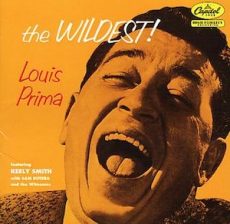
Daily Dose Of Jazz…
Louis Leo Prima was born December 7, 1910 in New Orleans, Louisiana into a musical Italian American family. His mother, a music lover, made sure that each child played an instrument, assigning him the violin and started out playing at St. Ann’s Parish. His interest in jazz came when he heard black musicians, including Louis Armstrong at a time Italians and Blacks in New Orleans frequently socialized together in the same clubs and bars.
He practiced continuously on his worn-down cornet and formed a band in 1924 with his childhood friends, bassist Candy Candido, Irving Fazola on clarinet and drummer Johnny Viviano. Prima attended Jesuit High School but transferred to Warren Easton High in 1926. There he played with the Eastonites, the school band. The next year he partnered with fellow musician Frank Federico and they played in the French Quarter.
By 1928 his decision was made to become a professional musician. After finishing high school he joined the Ellis Stratako Orchestra in 1929 then the Joseph Cherniavsky Orchestrafollowed by a temporary job playing on the steamship Capital that docked on Canal Street. His first break was when Lou Forbes hired him for daily afternoon and early evening shows at The Saenger.
1934 saw him begin recording for the Brunswick label. He recorded That’s Where the South Begins, Long About Midnight, Jamaica Shout, and StarDust. Prima and his New Orleans Gang featured Frank Pinero playing piano, Jack Ryan bass, Garrett McAdams guitar, and Pee Wee Russell clarinet. at the Famous Door. HIs recordings from 1935 were a combination of Dixieland and swing. He and Russell recorded The Lady in Red, a national jukebox hit. They also recorded Chinatown, Chasing Shadows and Gypsy Tea Room.
Martha Raye played a role in Prima’s professional and personal life and with her got his first national debut on The Fleischman Hour. He recorded Sing, Sing , Sing in 1936, which subsequently became a hit for Benny Goodman. Moving to California he expanded his music, joining the movement for big bands and orchestras. However for him the configuration was not successful.
He returned to New York City in 1937 with his quintet at the Famous Door. Then on to Billy Rose’s Casa Mañana club in 1938, earning nearly a quarter million dollars throughout seven weeks. This led to an East Coast to mid-West tour. During the war years, Louis was experiencing great success regardless of anti-Italian sentiment. He would go on to have several big hits but by the end of the war years, the popularity of big band music was diminishing. By 1947 he was playing more jazzy versions of his music for the next decade and a half.
Trumpeter, singer, entertainer and bandleader Louis Prima suffered a heart attack in 1973. Two years later he was diagnosed with a brain stem tumor, suffered a cerebral hemorrhage, went into a coma following surgery and never recovered. He moved back to New Orleans and transitioned three years later on August 24, 1978 at 67 in his hometown.
More Posts: bandleader,history,instrumental,jazz,music,trumpet
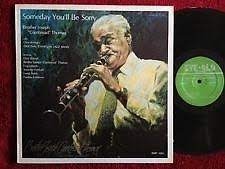
Daily Dose Of Jazz…
Joseph William Thomas was born on December 3, 1902 in New Orleans, Louisiana. His first professional gig was in his home city with trombone player Joe Harris in 1923. Soon after that, he worked with Jack Carey, Chris Kelly, and Kid Rena. He recorded with Charles Derbigny in 1941, but the recordings were not publicly released until the 1960s, by which time Thomas had become a figure in the Dixieland revival movement.
He led his own ensemble at New Orleans’s H&J Tavern for much of the 1940s, then in 1951, he became a sideman for Papa Celestin. He worked with this ensemble for years, including after Papa French and Eddie Pierson had taken over as leader.
Other associations in the 1950s and 1960s included work with Freddie Kohlman, Punch Miller, the Olympia Brass Band, and on Swedish television with Sweet Emma Barrett in 1968. In the 1970s he worked with the Legends of Jazz, replacing Joe Darensbourg.
Clarinetist and vocalist Joe Thomas, also known as Brother Cornbread and was closely associated with the New Orleans jazz scene, February 18, 1981 in New Orleans at 78.
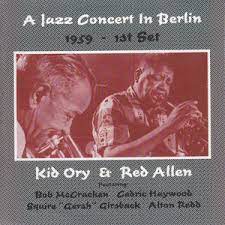
Daily Dose Of Jazz…
Robert Edward McCracken was born on November 23, 1904 in Dallas, Texas. Early in his career he played with local Dallas musicians like Jack Teagarden, Eddie Whitley, the Southern Trumpeters, and Doc Ross’s Jazz Bandits.
From 1926 to 1928 he lived in New York City where McCracken worked with Johnnie Johnston and Willard Robison’s Levee Loungers. After returning to Dallas, he worked with Ligon Smith, Joe Gill, and Ross again. He went on to tour with Joe Venuti and Frankie Trumbauer, before moving to Chicago, Illinois in 1939.
While in Chicago he played with Bud Freeman, and in the Forties he worked with Jimmy McPartland, Wingy Manone, Benny Goodman, Russ Morgan, and Wayne King. He substituted for Barney Bigard in the Louis Armstrong All-Stars international tour in 1952–53. Bob then toured internationally with Kid Ory and Red Allen throughout the 1950s.
During his later years in Los Angeles, California he played in several Dixieland revival groups, working with Ben Pollack, Pete Daily, Wild Bill Davison, and again with Teagarden, Ory, and Allen.
Clarinetist Bob McCracken, who is on many recordings including Kid Ory’s album, This Kid’s the Greatest, transitioned on July 4, 1972.
More Posts: clarinet,history,instrumental,jazz,music
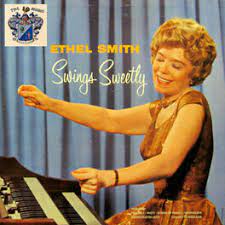
Daily Dose Of Jazz…
Ethel Smith was born Ethel Goldsmith on November 22, 1902 in Pittsburgh, Pennsylvania and began performing from a fairly young age. Traveling widely, after studying both music and several languages at Carnegie Institute of Technology, she became proficient in Latin music while staying in South America.
Smith performed in several Hollywood films such as George White’s Scandals and Melody Time. Her appearance in these films brought notoriety to her colorful, elaborate costumes, especially her hats.
Her rendition of Tico Tico became her best-known hit. She performed it in the MGM film Bathing Beauty in 1944, after which her recording reached the U.S. pop charts that November, peaking at #14 and selling nearly two million copies worldwide. Her other well known hits were Down Yonder and Monkey on a String.
Smith was a guitarist as well as an organist, and in her later years occasionally played the guitar live for audiences, but all her recordings were on the organ. She recorded dozens of albums, mostly for Decca Records.
Organist Ethel Smith, who became widely known as associated with Latin music, transitioned on May 10, 1996, at age 93 in Palm Beach, Florida.
More Posts: bandleader,history,instrumental,jazz,music,organ
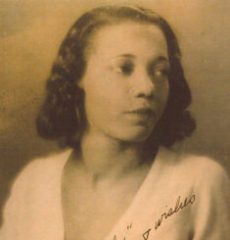
Jazz Poems
POEM Little brown boy, Slim, dark, big-eyed, Crooning love songs to your banjo Down at Lafayette– Gee, boy, I love the way you hold your head, High sort of and a bit to one side, Like a prince, a jazz prince, And I love Your eyes flashing, and your hands, And your patent-leathered feet And your shoulders jerking the jig-wa. And I love your teeth flashing, And the way your hair shines in the spotlight Like it was the real stuff. Gee, brown boy, I loves you all I’m glad I’m a jig. I’m glad I can Understand your dancin’ and your Singin’ and feel all the happiness And joy and don’t-care in you. Gee, boy, when you sing, I can close my ears And hear tom-toms just as plain. Listen to me, will you, what do I know About tom-toms? But I like the word, sort of, Don’t you? It belongs to us. Gee, boy, I love the way you hold your head, And the way you sing and dance, And everything. Say, I think you’re wonderful. You’re All right with me. You are. HELENE JOHNSONfrom Jazz Poems ~ Selected and Edited by Kevin Young
More Posts: book,classic,collectible,history,jazz,library,poet




